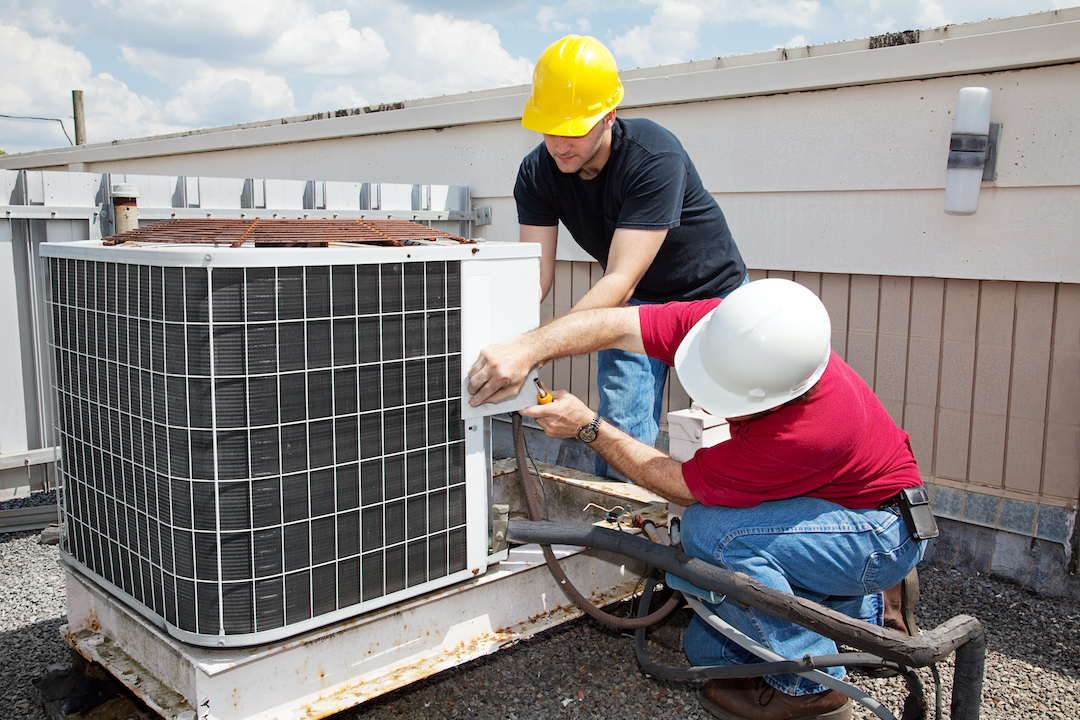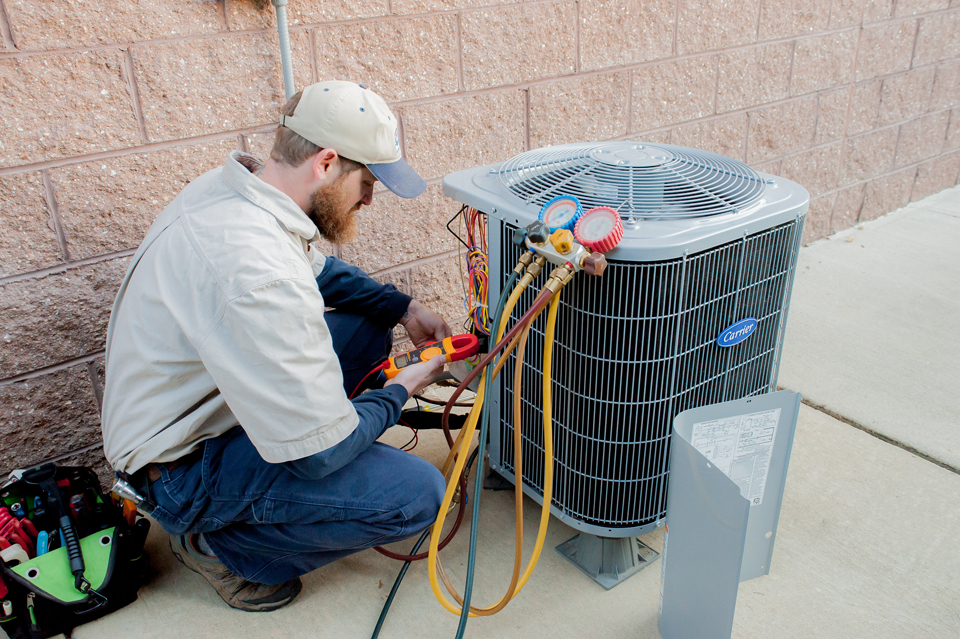Exactly How a Heatpump and Heater Work Together to Optimize Your Home's Heating Effectiveness
Comprehending exactly how a heatpump and furnace collaborate is important for property owners seeking efficient heating solutions. Each system has its strengths, offering a balanced method to home comfort. The warmth pump masters modest temperature levels, while the heater provides rapid heat throughout extreme cold. This synergy not just minimizes energy costs yet additionally boosts the life-span of both home appliances. What factors affect this collaboration, and exactly how can property owners optimize their advantages?
Understanding Heat Pumps: How They Work
Numerous people might be unfamiliar with their internal functions, heat pumps play a crucial duty in modern home heating systems. These devices operate by moving heat from one location to one more, using the concepts of thermodynamics. In chillier months, a warm pump essences warmth from the outdoors air, ground, or water, and transfers it inside your home to warm up the living room. On the other hand, throughout warmer months, it can turn around the procedure, functioning as an ac unit by expelling warm from inside to the outside.Heat pumps consist of an evaporator, compressor, development, and condenser valve. The cooling agent within the system takes in warmth as it vaporizes at low temperature levels and stress. The compressor after that increases the pressure and temperature level of the refrigerant, allowing it to release warm as it condenses. This efficient process can considerably lower power usage contrasted to conventional heating techniques, making heatpump a sustainable selection for climate control in homes.
The Function of Heating Systems in Home Heating
Furnaces play an essential role in home heating by giving a reputable source of warmth throughout the cooler months. They run by producing warmth with combustion or electrical resistance, distributing it throughout the home using air ducts or radiant systems. The effectiveness of a heating system is frequently determined by its Yearly Fuel Use Effectiveness (AFUE) rating, which indicates how efficiently the unit converts fuel into heat.Furnaces can utilize various power sources, consisting of gas, power, oil, or gas, enabling property owners to pick one of the most suitable choice for their requirements. Unlike heatpump, which might struggle in extreme cool, furnaces keep consistent efficiency, making certain that indoor temperatures continue to be comfortable regardless of outside conditions. In addition, modern furnaces usually come outfitted with sophisticated innovation, such as variable-speed blowers and clever thermostats, boosting their effectiveness and responsiveness. This adaptability makes heaters a vital element in all-inclusive home heating approaches.

Advantages of Utilizing Both Systems With Each Other
Incorporating the toughness of both heaters and heat pumps can result in an extra reliable and reliable home heating service. Utilizing both systems allows home owners to make use of the heat pump's energy performance throughout milder temperature levels while relying upon the heater for more severe cold conditions. This double approach can considerably reduce power prices, as heat pumps eat less electrical power than traditional home heating approaches when temperature levels are moderate.Additionally, utilizing both systems with each other can enhance comfort degrees in the home. Heatpump can offer constant, even home heating, while heating systems can quickly elevate ambient temperature levels when needed. Additionally, the assimilation of both systems can prolong the lifespan of tools by decreasing wear and tear on each unit, as they share the work. Ultimately, homeowners can delight in a balanced, economical home heating solution that readjusts perfectly to varying climate condition, making sure a cozy and inviting home throughout the winter months.
Exactly How Warm Pumps and Furnaces Enhance Each Other
They develop a complementary heating system that makes best use of efficiency and comfort when homeowners incorporate warmth pumps and heating systems. Heatpump run by transferring heat from the outdoors air or ground, making them very reliable in modest environments. They stand out throughout milder temperatures, supplying cost-efficient heating. Alternatively, furnaces produce warm through burning or electrical resistance, providing strong, instant heat during extreme chilly conditions.The mix of these 2 systems permits dynamic changes based on temperature level fluctuations. Throughout warmer months or milder wintertime days, the heatpump can take the lead, saving energy and reducing prices. As temperature levels drop, the heating system can perfectly involve, guaranteeing constant warmth throughout the home. This synergy not just optimizes power usage yet additionally boosts the lifespan of both systems, as each unit operates within its suitable efficiency range. With each other, they create a balanced environment that adapts to varying climate demands.
Maximizing Performance: Tips for Homeowners
Home owners can boost their heating performance through several useful techniques. Developing a routine upkeep routine, incorporating wise thermostat technology, and carrying out effective insulation and securing remedies are key steps. These procedures not only boost convenience but likewise minimize energy prices.
Regular Upkeep Schedule
To guarantee why not check here optimal home heating efficiency, developing a routine maintenance schedule is essential for any type of home. Homeowners must prioritize routine examinations of both heat pumps and furnaces to identify peak performance. This includes transforming air filters every one to 3 months, as clogged filters can substantially minimize effectiveness. Additionally, scheduling specialist upkeep a minimum of annually enables specialists to identify and deal with possible problems prior to they intensify. Home owners need to likewise cleanse the warmth pump's outside unit to avoid particles accumulation that can prevent airflow. By sticking to a regular upkeep timetable, property owners not just improve their heater' performance however likewise prolong their life expectancy, resulting in better convenience and decreased energy expenses throughout the cooler months.
Smart Thermostat Combination
Incorporating a smart thermostat right into a home heating unit can considerably improve power efficiency, specifically as it allows for specific control over temperature setups. These devices can learn the homeowner's routine and choices, immediately adjusting the temperature level to maximize convenience while lessening energy usage. As an example, they can reduce home heating throughout times when the home is unoccupied, lowering unnecessary intake. Lots of smart thermostats likewise offer real-time power use data, enabling house owners to make educated choices concerning their heating behaviors. Furthermore, remote access through smartphone apps allows customers to adjust settings from anywhere, making certain the home is warm upon return. Overall, smart thermostat combination not just enhances convenience yet significantly adds to energy savings and performance.
Insulation and Securing Solutions
Smart thermostats play a vital duty in energy efficiency, but their effectiveness can be considerably boosted by proper insulation and sealing services. Homeowners should focus on shielding floorings, attic rooms, and walls to decrease warm loss. Top quality insulation materials, such as spray foam or fiberglass, can substantially boost thermal resistance. In addition, securing spaces around doors, home windows, and air ducts stops cool air infiltration and warm retreat. Weatherstripping and caulking are efficient methods for attending to these leaks - ductless mini splits. Regular examinations for air leaks, together with using blower door tests, can aid determine problem areas. By purchasing insulation and securing, homeowners can enhance the performance of their heater, inevitably leading to reduced power consumption and reduced energy expenses
Usual Myths Regarding Warmth Pumps and Furnaces
What mistaken beliefs border heatpump and heating systems? Numerous individuals wrongly think that warm pumps are inefficient in cooler climates. Actually, modern warm pumps are designed to run efficiently even in low temperature levels, offering reputable home heating throughout winter months. An additional common myth is that furnaces are always extra efficient than warm pumps. This depends on the certain energy sources and efficiency rankings of the devices in inquiry. Some may additionally think that using both systems all at once is unnecessary, yet as a matter of fact, this combination can maximize heating performance, specifically throughout extreme weather conditions. In addition, people commonly think that heat pumps require constant upkeep, when in reality, they have similar maintenance needs to traditional furnace. By unmasking these misconceptions, homeowners can make more enlightened choices concerning their home heating choices, ultimately causing improved convenience and power effectiveness in their homes.
Maintenance Factors To Consider for Combined Equipments

Frequently Asked Questions
Can Heat Pumps Job Properly in Very Cold Climates?
Heatpump can my explanation have a hard time in extremely cool environments as a result of lowered efficiency and warm removal restrictions. However, advancements in modern technology have caused models made for better efficiency in such problems, improving their practicality in severe settings.
Just How Long Do Warm Pumps and Furnaces Generally Last?
Heatpump normally last 15 to 20 years, while furnaces have a lifespan of 15 to thirty years. Routine upkeep can prolong their durability, ensuring effective procedure and decreasing the requirement for early replacements.

What Is the Ordinary Cost of Setting Up Both Equipments?
The ordinary expense of mounting both a warmth pump and a furnace typically varies in between $5,000 to $10,000 - heat pump replacement ooltewah tn. Factors affecting this expense include system dimension, setup intricacy, and regional labor rates
Exist Tax Rewards for Using Energy-Efficient Home Heating Solutions?
Lots of homeowners ask about tax obligation motivations for energy-efficient heating unit. Different government and state programs usually offer rebates or credit scores, encouraging the adoption of sustainable modern technologies to reduce energy usage and promote ecological duty.
How Do I Choose the Right Size Warmth Pump and Heater?
Choosing the best size heatpump and heating system entails calculating the home's square footage, considering insulation quality, and assessing local climate. Consulting a professional can guarantee optimal system performance and power efficiency based on details demands. heat pump replacement ooltewah tn. Understanding how a warm pump and heating system work together is crucial for property owners seeking efficient home heating options. In chillier months, a warm pump essences heat from the outdoors air, ground, or water, and transfers it inside to heat the living area. When property owners integrate heat pumps and heaters, they produce a corresponding home heating system that makes the most of effectiveness and comfort. Warm pumps operate by moving warm from the outside air or ground, making them very efficient in moderate environments. Warm pumps can struggle in exceptionally chilly environments due to minimized performance and warm removal constraints